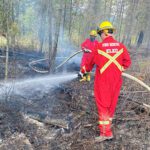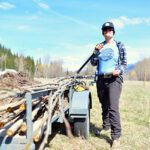Home »

Chronic Wasting Disease info sessions August 13
 On Tuesday, August 13, there will be two one-hour information sessions on the risks and realities of Chronic Wasting Disease at the Cranbrook Public Library.
On Tuesday, August 13, there will be two one-hour information sessions on the risks and realities of Chronic Wasting Disease at the Cranbrook Public Library.
Wildlife Health Biologist Cait Nelson will be making the presentations and talking about how people can help.It is an important subject for those who enjoy hunting, the outdoors and our wildlife.
The two sessions will be held at 2-3 p.m. and 5-6 p.m.
What is Chronic Wasting Disease?
Chronic Wasting Disease (CWD) is a deadly infection that affects the central nervous system of cervids (members of the deer family) such as mule deer, white-tailed deer, elk, moose and caribou. The disease is caused by an abnormal protein called a prion, which can be transmitted through saliva, urine, feces, carcasses and even plants and soil. Signs of infection in deer include weight loss, poor coordination, stumbling and trembling. However, the disease is not obvious in early stages.
CWD is similar to bovine spongiform encephalopathy – commonly known as mad cow disease – in that is it also caused by a prion. However, there is no direct evidence that CWD can be transmitted to humans. That said, as a precaution, any animal suspected or confirmed to have CWD should not be consumed.
For the current distribution of CWD in North America see the latest USGS map.
Why should we care?
CWD is not known to affect humans, but for wildlife populations it can be devastating. The disease can be transferred between deer through multiple ways and an infected animal may be contagious for months or years before appearing sick. Moreover, CWD is always fatal.
Although its presence has not yet been detected in B.C., CWD has continued to spread in all affected jurisdictions despite mitigation and management efforts. In June 2019, the disease was detected in deer in Libby, Montana – very close to the B.C. border. This significantly increases the disease risk to B.C.’s cervid populations and requires a collaborative, coordinated and rapid response.
What is B.C. doing about it?
Since 2002, the B.C. Wildlife Health Program has tested over 3900 cervids for CWD and the disease has not yet been detected in B.C. However, sample numbers in recent years have not consistently provided confidence in disease absence in the province.
See the Surveillance and Response Plan for CWD in B.C. (2019).
How can you help?
You can be part of the solution by understanding the risks, reporting sick animals and submitting a head for testing.
Understand the risks
Human importation of infected tissue is the highest threat of introduction to B.C. wildlife. If you hunt in areas where CWD affects wild deer, please do not bring intact carcasses or any high-risk tissues (brain, spinal cord, lymph nodes, organs) back to B.C. This is prohibited by law as outlined in the B.C. Hunting Regulations (2018-2020). It is good practice to leave the high risk tissues at the kill site so as to not inadvertently move infected tissues to new areas.
Report sick animals
Whether you are in the backcountry or in your backyard, you can help by being our ears and eyes on the ground. It is uncommon to observe CWD-associated symptoms in the wild because infected animals become more vulnerable to predators as the disease progresses. That said, if you see a deer, elk, moose or caribou exhibiting any of these symptoms: weight loss, drooling, poor coordination, stumbling, trembling or little fear of people, please report your observations to the RAPP Line or the B.C. Wildlife Health Program.
Submit a head for testing
Surveillance for CWD in B.C.’s cervid populations is important for two reasons. First, we have to look for the disease to be able to confirm B.C.’s CWD-free status. Second, if the disease does enter B.C., we need to detect it as early as possible to improve our chances of containing it. Hunters are encouraged to submit their deer, elk or moose head for CWD testing. This is voluntary in most parts of B.C. but will be mandatory in specific Management Units along the B.C.-Montana border for the 2019 hunting season. See B.C. Hunting Important Notices.
It is ok to remove the antlers and top of the head (skull plate) before submitting. The tissues that we test for CWD are at the base of the skull and back of the throat. For European mounts please submit the following tissues: Lower jaw and all tissues from the roof of the mouth at the back of the throat.
To learn more, please visit: www.gov.bc.ca/chronicwastingdisease.ca
Information from B.C. Wildlife Health Program
Wildlife and Habitat Branch,
Forests, Lands, Natural Resource Operations and Rural Development







